- Monthly plans start at $19.95
- 30-day trial period
- Two-for-one bundles for couples or roommates
One Call Alert Review 2025: A Standard Medical Alert System With Two-for-One Bundles
Key Takeaways
- One Call Alert offers at-home and on-the-go medical alert systems that connect to a 24/7 monitoring center.
- Monthly prices range from $19.95–$44.95, depending on the package you choose. Discounts are available with annual, semiannual, and quarterly payment plans with most packages.
- Fall detection is $11 per month.
- The company offers two-for-one bundle packages, which include two medical alert systems for one monthly monitoring fee.
Medical alert systems, like One Call Alert, offer a constant connection to a 24/7 monitoring center in case of an emergency. While some people who could benefit from one may be hesitant to adopt a medical alert system into their daily routine, research shows these devices can help users feel more independent and secure.1
One Call Alert is a medical alert system company based in Houston, Texas. It’s owned by the popular brand MobileHelp and offers similar at-home and on-the-go medical alert systems. One Call Alert also has two-for-one bundles, which are great for couples or roommates.
Learn about the pros and cons of One Call Alert medical alert systems, as well as cost, the return policy, and more in our One Call Alert review.
Why you can trust our expert review
Our team spent more than 2,500 hours conducting in-depth research on medical alert systems. During our process, we:
- Engaged in ongoing independent research
- Consulted with licensed adult caregivers, doctors, and nurse practitioners who specialize in older adult care
- Mystery shopped 13 medical alert system brands
- Surveyed 1,000 medical alert system users
- Tested various medical alert systems
- Read hundreds of verified customer reviews from trusted third parties, such as Better Business Bureau (BBB) and Trustpilot
Read more about our medical alert systems review methodology.
Why One Call Alert is one of our top picks
One Call Alert is a top brand featured in our best medical alert systems review. It’s one of the only companies that bundles two medical alert systems for an affordable monthly price.
One Call Alert offers nearly identical equipment as its parent company, MobileHelp. Although we haven’t tested One Call Alert, we tested MobileHelp during our medical alert system testing summit, which allowed us to experience how One Call Alert works. (That is why we named MobileHelp “Best Two-for-One Bundle” in our best medical alert systems review.)
We’ll speak to our firsthand experience testing similar equipment when relevant.
Pros and cons of One Call Alert
Table 1 Comparison of One Call Alert medical alert systems
| In-Home Landline | In-Home Wireless | Mobile On-the-Go | All-in-One | Complete Protection | Mobile Double | |
|---|---|---|---|---|---|---|
| Starting monthly cost | $24.95 | $19.95 | $37.95 | $39.95 | $41.95 | $44.95 |
| Equipment fee | $0.00 | $0.00 | $0.00 | $0.00 | $0.00 | $0.00 |
| Activation fee | $0.00 | $49.95 | $0.00 | $0.00 | $0.00 | $0.00 |
| Device type | At-home | At-home | On-the-go | On-the-go | At-home, on-the-go | On-the-go |
| Device range (feet) | 600 | 1,400 | Unlimited | Unlimited | 1,400 (at-home) Unlimited (mobile) | Unlimited |
| Connection type | Landline | AT&T cellular | AT&T cellular, GPS | AT&T cellular, GPS | AT&T cellular, GPS (mobile) | AT&T cellular, GPS |
| Battery life | 32 hours | 32 hours | 24 hours | 4 days | 32 hours (at home) 24 hours (mobile) | 24 hours |
| Location tracking | No | No | Yes | Yes | Yes (mobile) | Yes |
| Water-resistant or waterproof | Waterproof help button | Waterproof help button | Waterproof help button
Water-resistant (mobile) | Water-resistant | Waterproof help button
Water-resistant (mobile) | Water-resistant |
| Two-way voice communication | Yes | Yes | Yes | Yes | Yes | Yes |
One Call Alert medical alert systems
In-Home Landline

- Monthly fee: $24.95
- Device type: At-home
- Device range: 600 feet (ft)
- Device dimensions: 6.3 x 8.3 x 2.2 inches (length x width x height)
- Device weight: 15.8 ounces (oz)
- Connection type: Landline
- Battery life: Up to 32-hour backup battery
The In-Home Landline requires an active landline to connect to the 24/7 monitoring center. If you live in an area with spotty or unreliable cellular service and spend the majority of your time at home, you might want to consider this system. Unfortunately, the In-Home Landline has the shortest connection range between the help button and base station: 600 feet. With a shorter range, there may be a lapse in connection to the monitoring center if you have a two-story home or a larger yard.
When going through the online checkout process, we noticed there wasn’t an option to choose between a help button necklace or a wristband. A customer service representative confirmed the In-Home Landline includes a help button that switches between a necklace or wristband, both of which come with the package. This is unlike other packages that require you to choose one or the other. We like the versatility of a help button that you can wear as a necklace or wristband.
Unfortunately, fall detection is unavailable for this package, which is a major drawback if you or your loved one are more susceptible to falls due to health issues or limited mobility. Consider the In-Home Wireless if you’d like an at-home system with fall detection.
We like that the base station has a large button labeled “HELP,” which makes it simple to push during an emergency. It also has a two-way speaker, so you can communicate directly with the monitoring staff if you’re in the same room as the base station.
In-Home Wireless

- Monthly fee: $19.95
- Device type: At-home
- Device range: 1,400 ft
- Device dimensions: 5.5″ L x 7.1″ W x 3″ H
- Device weight: 14.5 oz
- Connection type: AT&T cellular
- Battery life: 32 hours
The In-Home Wireless offers more perks compared to the In-Home Landline: optional fall detection, AT&T cellular service connection, and more than double the range between the help button and base station.
With this model, you’ll choose between a waterproof help button wristband or necklace. The button connects up to 1,400 feet away from the base station, which is longer than three football fields—making it a good option if you need to be connected to 24/7 monitoring services while at home.
Fall detection is available for an additional $11 per month. If you add this feature to your In-Home Wireless package, you’ll receive a designated fall detection necklace ⓘA fall detection necklace has a built-in sensor that detects downward motion. It automatically contacts the monitoring center if it detects a fall, even if the user didn’t press the help button. Remember, fall detection does not prevent falls, but it helps you get immediate emergency assistance to avoid a “long lie ⓘA long lie occurs when a person falls and is unable to get up from the floor for an hour or more. Long lies have been associated with several types of long-term health complications..”

The In-Home Wireless system can also remind users when it’s time to take their medication. For $5 per month, you can set medication reminders through the One Call Alert app or online portal.
The base station beeps at the designated reminder time, and the user confirms they’ve taken their medication by pressing the base station’s blue “Reset” button. This service may be unsuitable for those with memory loss or dementia since it doesn’t state the medication or dosage.
A downside of In-Home Wireless is the $49.95 processing fee, which covers set up. This is the only One Call Alert medical alert system with an extra fee, but you can have this fee waived if you choose the annual payment plan of $359.40.
The in-Home Wireless system is the only One Call Alert package that has an overall monthly price increase instead of a decrease when you get the annual, semiannual, or quarterly payment plan. The monthly cost breakdown is $29.95 ($359.40), $29.95 ($137.70), and $32.95 ($98.85), respectively. For this reason, we recommend the monthly payment plan for cost savings.
Mobile On-the-Go
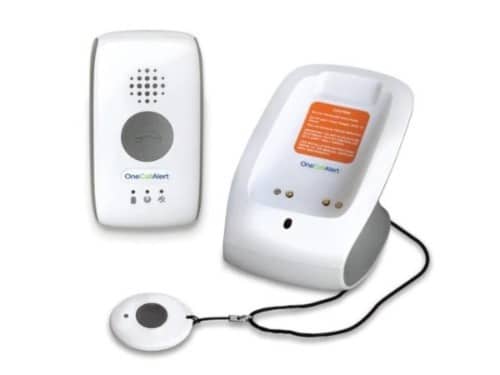
- Monthly fee: $37.95
- Device type: On-the-go
- Device range: Anywhere with AT&T cellular service
- Device dimensions: 0.75″ L x 1.8″ W x 3.1″ H
- Device weight: 2.7 oz
- Connection type: AT&T cellular
- Battery life: Up to 24 hours
The Mobile On-the-Go is about the size of a pager and connects to the monitoring center anywhere with AT&T cellular service. If you’re active outside your home and drive independently, we recommend a mobile system that allows you to connect to help with a single button press.
While you can wear the Mobile On-the-Go around your neck, the package also includes your choice of a help button necklace or wristband. This allows you to tuck the device into your pocket or purse while wearing the smaller necklace or wristband for a more discreet connection to the monitoring center.
Fall detection is available for the Mobile On-the-Go, but the feature isn’t built into the device. You’ll need to wear a designated fall detection necklace to use this feature.
If that’s too many necklaces and buttons to keep track of, consider the All-in-One mobile system in the next section.
The Mobile On-the-Go has a 24-hour battery life, so you’ll need to place it in the charging cradle each night to make sure it has full battery life for the next day. The device uses a verbal message and flashing light to indicate when the battery is low.
When you’re wearing the device your loved ones can monitor your location (with built-in GPS tracking). Caregivers can check the location of the Mobile On-the-Go through the app or online portal.
Another perk is the built-in two-way speaker, which allows you to speak with a monitoring staff member during an emergency.
While we have not tested the Mobile On-the-Go, we’ve tested the MobileHelp Solo, which is a similar device. Both devices have a small power button and test call button on the side.
We had difficulty pushing the MobileHelp Solo test button, which may be even more difficult for a user with dexterity issues or arthritis. The small buttons may also be hard to see for users with reduced vision.
The Mobile On-the-Go help button may also be hard for some users to navigate and press based on our experience with the MobileHelp Solo. We had to push it for more than two seconds before the device contacted the monitoring center.
All-in-One
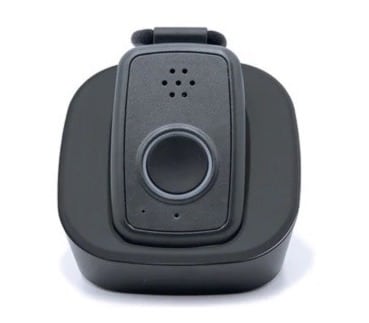
- Monthly fee: $39.95
- Device type: On-the-go
- Device range: Anywhere with AT&T cellular service
- Device dimensions: 0.75″ L x 1.71″ W x 2.74″ H
- Device weight: 1.8 oz
- Connection type: AT&T cellular, GPS
- Battery life: Up to four days
The All-in-One is the smallest, most compact mobile medical alert system from One Call Alert. At 1.8 ounces, it weighs less than half a stick of butter. The All-in-One includes a two-way speaker and GPS tracking, like the Mobile On-the-Go, but what stands out is its built-in fall detection and four-day battery life.
When you add fall detection to your All-in-One, you don’t need to wear a separate fall detection necklace—the feature is built into the device. But be aware that, in general, fall detection necklaces are more accurate than other fall detection devices.
The All-in-One is also water-resistant, meaning it can be splashed with water and still work properly. You can wear it when showering, if you’re caught in the rain, or when working up a sweat during your favorite outdoor activity. While it will hold up in fairly wet conditions, it’s not waterproof, so the device shouldn’t be fully submerged in water.
The One Call Alert All-in-One is equivalent to the MobileHelp Micro, which we tested. We thought the Micro was comfortable to wear around our neck, but we did notice the device’s weight when we stood up and sat down.
The Micro help button was also difficult to push, and like the MobileHelp Solo, you must push it for at least two seconds to call the monitoring center.
While these observations are from testing MobileHelp medical alert systems, we wanted to include them here since these two systems are made by the same company.
Complete Protection

- Monthly fee: $41.95
- Device type: At-home, on-the-go
- Device range:
- 1,400 ft (at home)
- Anywhere with AT&T cellular service (on-the-go)
- Device dimensions:
- 5.5″” L x 7.1″ W x 3″ H (at-home)
- 0.75″ L x 1.8″ W x 3.1″ H (on-the-go)
- Device weight:
- 14.5 oz (at-home)
- 2.7 oz (on-the-go)
- Connection type: AT&T cellular
- Battery life:
- 32-hour backup (at-home)
- 24 hours (mobile)
The Complete Protection package comes with the In-Home Wireless base station and Mobile On-the-Go. This package is great for couples, roommates, or two people with different activity levels or schedules who want a 24/7 monitoring center connection.
Fall detection necklaces are available for both the at-home and mobile systems. You can also add medication reminders to the at-home base station. Like the In-Home Wireless package, you’ll manage the medication reminders from the app or online portal.
If you choose the annual, semiannual, or quarterly payment, each device is less than $20 per month. Even with the monthly payment plan you’ll be getting an excellent deal at $21 per month for each system.
Mobile Double
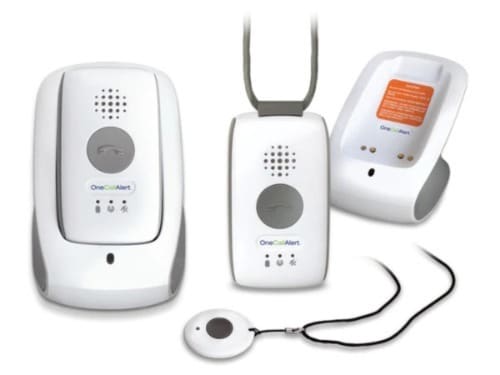
- Monthly fee: $44.95
- Device type: On-the-go
- Device range: Anywhere with AT&T cellular service
- Device dimensions: 0.75″ L x 1.8″ W x 3.1″ H
- Device weight: 2.7 oz
- Connection type: AT&T cellular
- Battery life: 24 hours
The Mobile Double bundles two Mobile On-the-Go systems into one package. These systems have all the same features as the Mobile On-the-Go package, including an optional fall detection necklace for $11 per month.
If you choose the monthly payment plan, each mobile system breaks down to $22.48. This is almost $16 less per month for each mobile system compared to $37.95 for one Mobile On-the-Go. You’ll save even more with an annual, semiannual, or quarterly payment plan.
This package is a great way to save money for couples or roommates.
How much does a One Call Alert medical alert system cost?
With a monthly payment plan, One Call Alert medical alert systems cost between $19.95–$44.95 per month, depending on the package you choose. This falls into the general average cost of medical alert systems.
Depending on the package and payment plan, you can save $2–$8 on monthly monitoring if you choose an annual, semiannual, or quarterly payment plan.
In-Home Wireless is the most affordable package, with a monthly payment plan of $19.95. Compared to the other payment plans for this package, the monthly plan is the best option for cost savings:
- Annually ($29.95 per month)
- Semiannually ($29.95 per month)
- Quarterly ($32.95 per month)
The pricing chart on the brand’s website comparing each package is misleading because the monthly rates shown in the chart are the discounted monthly rates for an annual payment plan. To see the annual, semiannual, quarterly, and monthly costs for each package, click Buy Now at the bottom of the chart.
One Call Alert offers free ground shipping for annual, semiannual, and quarterly plans. Shipping is $16 for monthly plans. The In-Home Wireless is the only package with a one-time processing fee of $49.95, which is waived when you sign up for the annual payment plan.
One Call Alert trial period and warranty
You have 30 days to return your One Call Alert medical alert system and receive a full refund. If you or your loved one are unsure about using a medical alert system, this trial period allows you to test it out without making a commitment.
Even if you decide to cancel your subscription after the 30-day trial period, you won’t be penalized. You’ll receive a refund for any months of service you didn’t use, but you’re responsible for shipping costs when returning equipment.
One Call Alert will repair or replace your medical alert system for free if it has a manufacturing defect (like a manufacturer’s warranty). We confirmed with a customer service representative that there are no time constraints with this warranty.
One Call Alert accessories
The following accessories are available with One Call Alert medical alert systems:
- Connect Premium: This benefit program provides equipment replacement, a fixed monthly price for your first two years, 25% off fall detection, and 30 additional location requests with mobile devices. ($6 per month)
- Fall detection necklace: The All-in-One is the only system that doesn’t require an additional necklace for fall detection—the feature detection is built into the All-in-One device when you opt for this feature ($11 per month).
- Lockbox: One Call Alert includes a free lockbox ⓘTypically attached to the outside of your home, a medical alert lockbox is a common add-on accessory that stores a house key, giving emergency responders access to the home. with every subscription.
One Call Alert app
One Call Alert uses the same app as its parent company MobileHelp: MobileHelp Connect. You can download MobileHelp Connect for free from the App Store or Google Play.
The MobileHelp Connect app allows you to:
- Manage emergency contact information
- Update user information (health information, lockbox code, etc.)
- Manage payment and billing information
- Track mobile device location
- Add medication reminders (only for In-Home Wireless and Complete Protection)
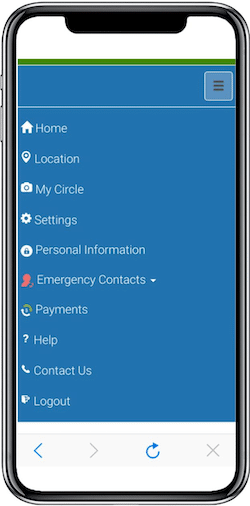
We used the MobileHelp Connect app when testing MobileHelp during our medical alert system testing summit. Overall, we thought the app was straightforward and simple to use, but we had some issues with GPS location tracking.
The device’s location was logged as latitude and longitude coordinates throughout the day, which is difficult to decipher, and we were unable to track our movement with the device in real time. For those needing easy to understand real time GPS monitoring, this app will not be adequate.

The “Locate Now” feature is also not as immediate as we would like. When using this feature, a pop-up in the app stated, “Location successfully sent. It may take up to five minutes to locate the device.” The app did not notify us when the device’s location was updated.
We do like that you can press “See Map” next to the coordinates to view the device’s location on Google Maps, but these are previous location logs.
One Call Alert customer service and satisfaction
You can contact One Call Alert customer service over the phone at 800-913-9098 or through online chat.
Phone availability:
- Monday through Friday, 8 a.m. to 6 p.m. ET
- Saturday, 9 a.m. to 6 p.m.
Chat availability:
- Monday through Friday, 8 a.m. to 6 p.m. ET
When we called customer service, an automated voice announced we couldn’t speak with a representative until we pressed one. This voice also stated that pressing one would confirm we were interested in becoming a One Call Alert customer and agreed that “One Call Alert may call or text you about your inquiry.”
We don’t like that shoppers can’t speak with a customer service representative without agreeing to receive sales calls and texts from the company. This feels like a pushy sales tactic, which may be off-putting for some shoppers.
We mainly interacted with One Call Alert customer service through the online chat feature. We immediately spoke with a live representative almost every time we used online chat.
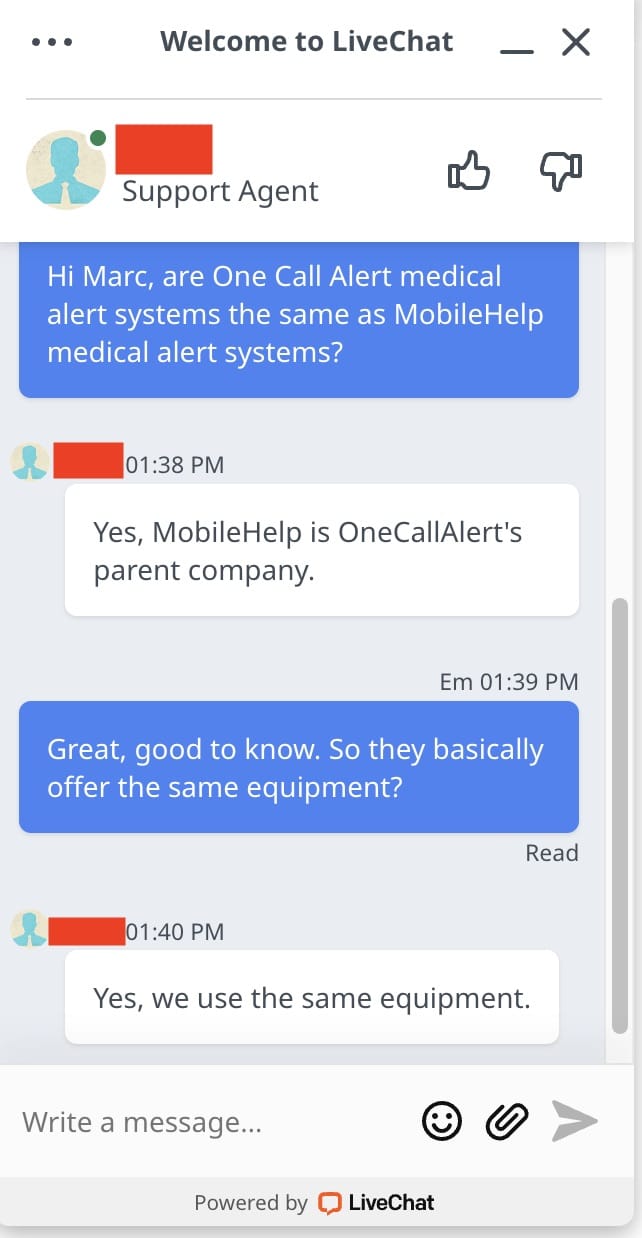
In one instance, we asked a question about shipping and didn’t receive a response. We were transferred to another live chat representative and had to repeat our question, but they were able to answer it promptly.
We recommend online chat for quick questions or to learn about product features or policies. If you’d like a more in-depth overview of One Call Alert medical alert systems and are willing to opt-in for calls and texts from the company, it’s better to speak with a representative over the phone.
Table 2 Comparing One Call Alert to other top medical alert systems
| One Call Alert | MobileHelp | Medical Guardian | Bay Alarm Medical | ADT | Life Alert | |
|---|---|---|---|---|---|---|
| Starting monthly cost | $19.95 | $19.95 | $29.95 | $27.95 | $29.99 | $49.95 |
| Device range (ft) | 600–1,400 | 600–1,400 | 1,300–1,400 | $1,000.00 | 300–600 | $800.00 |
| Connection type | Landline, AT&T cellular | Landline, AT&T cellular | Landline, AT&T or Verizon cellular | Landline, AT&T or Verizon cellular | Landline, AT&T cellular | Landline, cellular |
| Fall detection (per month) | $11.00 | $11.00 | $10.00 | $10.00 | $11.00 | N/A |
| On-the-go options | Yes | Yes | Yes | Yes | Yes | Yes |
| Maximum on-the-go battery life | 4 days | 3 days | 5 days | 6 days | 40 hours | 10 years |
| Location tracking | Yes | Yes | Yes | Yes | No | Yes |
| Water-resistant | Yes | Yes | Yes | Yes | Yes | Yes |
One Call Alert customer reviews
One Call Alert is accredited by the Better Business Bureau (BBB) and has an A-plus rating, but there are only three customer reviews with the BBB. All reviews are one-star reviews as of this writing, and the main complaints were:
- Billing and refund issues
- Receiving continuous robocalls and robotexts from the company
The company has 4.8 out of 5 stars on Google Reviews based on 125 reviews. Almost all of the reviews are positive and focus on excellent customer service and a pleasant, smooth purchasing process.
“Thank you for the quick response, patience with answering all of our questions, and overall experience. We were not happy with our old service and One Call has made a world of difference for us. I know my grandfather will be safe.”
Nicole G. (GOOGLE REVIEWS)
“The agent was very helpful and I paid in two installments. I’ve had it go off twice (my fault) and they were very quick to answer the alarm. After I told them it was my fault, they were understanding and asked if everything was ok in the home.”
Michelle A. (GOOGLE REVIEWS)
There were only a few negative reviews, which mostly touched on refund issues and poor customer service.
“Be careful! I signed up my brother, who lived a distance away from me, for this service. He ended up going into a facility and never used the service. I called One Call to cancel service. Family members in the area were unable to find the equipment—who knows what happened to it. But I continued to be charged every three months, paying way OVER the cost of the equipment, and they refuse to refund me. Not an ethical company.”
Sylvia O. (GOOGLE REVIEWS)
One Call Alert hasn’t claimed its Trustpilot profile and has no customer reviews or ratings.
Bottom line
One Call Alert offers at-home and on-the-go medical alert systems with standard features, like fall detection and mobile GPS tracking. Some of its standout features include:
- $19.95 starting monthly price (In-Home Wireless package)
- 1,400-foot range (In-Home Wireless package)
- Two devices in one bundle
Two of its biggest drawbacks:
- No fall detection for the landline at-home system
- Fall detection is $11 per month ($10 for most brands)
We recommend One Call Alert for shoppers looking for a simple medical alert system.
“When deciding between an at-home or mobile medical alert system, consider the individual’s lifestyle, mobility, and medical needs,” said Sean Marchese, a registered nurse at the Mesothelioma Center in Orlando, Florida, with more than 20 years of patient care experience, including nursing home care.
“A portable option is best if they’re often out and about or have an active lifestyle. But an at-home system works well if they stay home or have limited mobility.”
If you’re looking for a more innovative, tech-forward device, like a medical alert watch or a voice-activated medical alert system such as Aloe Care Health, then One Call Alert may not be for you.
Frequently asked questions
One Call Alert systems are $19.95–$44.95 per month, depending on the package. The In-Home Wireless system has a $49.95 processing fee, but no other packages include this additional fee. You can save $2–$8 on your monthly monitoring fee and get free shipping with an annual, semiannual, or quarterly subscription (excluding In-Home Wireless). Ground shipping is $16 when you purchase a monthly subscription.
No. Traditional Medicare (Part A and B) does not cover medical alert systems. Medicare Advantage (Part C) plans may offer partial or complete coverage for One Call Alert medical alert systems. Medicare Advantage coverage varies by plan, so check coverage details with your insurance provider.
Yes, One Call Alert is a legitimate medical alert system company. One Call Alert was founded in 2013 and is based in Houston, Texas. It was acquired by MobileHelp, another medical alert company. One Call Alert has an A-plus rating with the Better Business Bureau and 4.8 out of 5 stars on Google Reviews.
Yes, One Call Alert is a good medical alert device and is featured in our best medical alert systems review. One Call Alert has an affordable starting price compared to most medical alert systems ($19.95), offers fall detection, a free caregiver app, and doesn’t charge activation or equipment fees for almost all packages.
We recommend One Call Alert instead of Life Alert. Our Life Alert review covers major drawbacks of this well-known company: a required three-year contract, no fall detection, no pricing information available online, and high monthly fees ($49.95–$98.95).
One Call Alert doesn’t require a contract, has a 30-day trial period, fall detection, and packages start at $19.95 per month.
Medical alert systems can provide vital emergency assistance and peace of mind for older adults and their families. Research shows that users feel more secure knowing help is a button press away. These devices allow people to maintain independence while getting support when needed.
Considering the 24/7 emergency monitoring and quick response times, most users find medical alert systems to be well worth the monthly fee. As an investment in health and safety, they deliver invaluable security.
Have questions about this review? Email us at reviewsteam@ncoa.org.
Sources
- Stokke, R. The Personal Emergency Response System as a Technology Innovation in Primary Health Care Services: An Integrative Review. Journal of Medical Internet Research. July 2016. Found on the internet at https://www.jmir.org/2016/7/e187/

